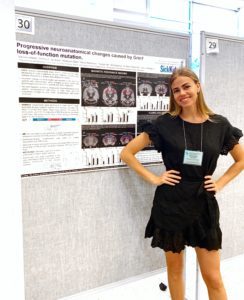Katheron Intson is a passionate scientist; she likes understanding how and why things work the way that they do. So when Katheron’s friend reached out about a mysterious health problem, Katheron (“Kath”) was intrigued. Her friend was preparing for surgery but was nervous as, in the past, pain medicine had never been effective. Would Kath be open to doing some research or providing some insight?
Since meeting and speaking to her, I have watched Kath immerse herself in research and exploration for a variety of new conditions – so to me, it was no surprise that she jumped in head-first to help her friend. She started searching for whether others had the same problem. During her research, Kath noticed that the drugs her friend failed to respond to were all opioids; this spurred her to question whether her friend had a mutation in an opioid receptor gene. These mutations would prevent drugs from binding to the receptor, causing no pain relief. Two years after testing, her friend’s mutation was confirmed.
Katheron explains:
There’s a lot to cover in terms of genetics. Many geneticists or doctors don’t hear about this stuff; it would be impossible and impractical to expect them to know about every single genomic alteration or mutation and what disorder results from it. But this is what led me to build Varient – the realization that precision medicine is here. When we run whole genome sequencing on any person, each one will have some sort of medically meaningful variant in their genetics.
Varient is starting with the rare disease community and works to provide quantified medication outcomes for patients with rare diseases. During our interview, we discussed what spurred Katheron’s interest in science, her research into GRIN-related disorders, and how she hopes Varient will accelerate rare disease research and understanding.
Katheron’s Story
When Katheron first started pursuing her undergraduate degree at Queen’s University in Kingston, Ontario, science was actually not her focus. In fact, some might say that she was on the other end of the spectrum – studying art. But her trajectory changed when she took a course on behavior. She explains:
I became incredibly interested in the brain and how we learn, how we remember things. Where did our genes come in and how do they interact with the environment?
During her undergraduate career, she worked in the Neurobiology of Anxiety Laboratory under Dr. Janet Menard, studying neuronal activity and the serotonin system in rats exposed to early adversity, and later went on to study neuroinflammatory enzymes in NMDA-receptor knockdown mice at the University of Toronto.
Now, Katheron is pursuing her PhD in Pharmacology & Toxicology at the University of Toronto. It is here that she began working in Dr. Amy J. Ramsey’s lab. She shares:
Dr. Ramsey is an expert in GRIN1, which is a very important gene in the neuroscience world since it has so much of an impact on learning and memory. This is a highly-studied gene, so we were always trying to understand its mechanisms. When you put a GRIN1 variant into a mouse, you end up with a mouse that doesn’t learn. But after a couple years of our research, we started getting emails from families impacted by GRIN1 variants as the world of genetic testing expanded.
For a full list of Katheron’s publication credits, click here.

About GRIN Disorders
GRIN disorders refer to a group of rare genetic conditions related to ionotropic glutamate receptors. These conditions, which can have serious and life-threatening symptoms, are caused by a mutation in one of seven genes. For example, GRIN1, GRIN2A, GRIN2B, and GRIN2D have all been implicated in the development of a GRIN disorder. Typically, these mutations are not inherited, but occur spontaneously or sporadically. These genes play a role in NMDA receptor creation; as these play a role in learning and memory, individuals with GRIN disorders often experience intellectual and developmental delays.
What is GRIN1?
Katheron’s PhD lab has a particular focus on GRIN1-related disorders. According to the Children’s Hospital of Philadelphia (CHOP):
Pathogenic variants (‘mutations’) in the GRIN1 gene cause a spectrum of neurodevelopmental disorders that can include childhood-onset epilepsy, developmental delays, movement disorders, and features of autism spectrum disorder. The symptoms a child experiences and the severity of the disorder can vary widely.
Symptoms and characteristics associated with GRIN1 mutations typically manifest anywhere from shortly after birth to within two years old. These can include:
- Developmental delay
- Cognitive impairment
- Microcephaly (abnormally small head)
- Seizures, including:
- Infantile spasms
- Absence seizures
- Tonic-clonic seizures
- Focal motor seizures
- Focal impaired awareness seizures
- Central hypotonia
- Muscle spasticity in the limbs
- Dystonia
- Aggression or hyperactivity
- Autism spectrum disorder
- Feeding difficulties
- Cortical visual impairment
Connecting with the GRIN1 Community
A few years into her research, Katheron noticed that families began reaching out to the lab in search of answers. She shares:
Families were saying that their child had just been diagnosed with a GRIN1 variant, but they couldn’t really learn much, and their doctors didn’t know anything about this gene. So they were looking to us because we were studying mice with this variant. At first, we were just a bunch of academics studying a gene, but the next thing we knew, we were getting deeper and deeper into the world of personalized medicine and clinical genetics.
One of the reasons families were so drawn to the Ramsey lab was that the research team had just finished a particularly intriguing study. First, the researchers had taken mice models of GRIN1 and allowed them to grow up. Once the mice had matured, the researchers reversed the mutations. Katheron explains:
All of the parallels that we were seeing between the mice and the kids – cognitive impairments, motor deficits, seizures – all got better in the mice once the variants were reversed. We saw the amelioration of behavioral issues. This research showed the fundamental plasticity of the adult brain in a way that, prior to this study, we hadn’t known was possible. I only played a minor part in that study, but I had also done a study where I looked at brain structure shrinkage and atrophy in GRIN1 mice as they got older. Taken together, this teaches us that even in the face of MRIs or tests that don’t look very good, change is possible in a very positive way.
Katheron found herself invigorated by this research. Yet despite these positive and optimistic research advances, there is still a long way to go for families touched by this condition. Kath hypothesizes that we are still anywhere from 10-15 years away from developing an effective GRIN1 gene therapy. But, excited by the research, more families continued to reach out. At least ten families contacted Kath personally on social media; through this, she was connected to a foundation with hundreds of families. She began attending conferences and meetings where families, researchers, and clinicians all get together to speak.

Soon, Kath became aware of a trend within the GRIN1 community – and within the rare disease community as a whole: medication comparison. Families compared which medications they were using, which genetic variants their children had, and how those medications affected outcomes. This is especially important in the interim between now and gene therapy development, as it allows drugs on the market to be repurposed and used to keep symptoms at bay.
Wanting to make an actionable change and impact on this community, Kath had an idea to build a tool for parents and families to compare medications and outcomes based on variant, a tool which could sort people into genetic groups and let them see aggregate medication information.
And just like that, Varient was born.
Join us in Part II of our interview, where we discuss the details of Varient, the importance of data, and where Katheron sees Varient growing in the future.


